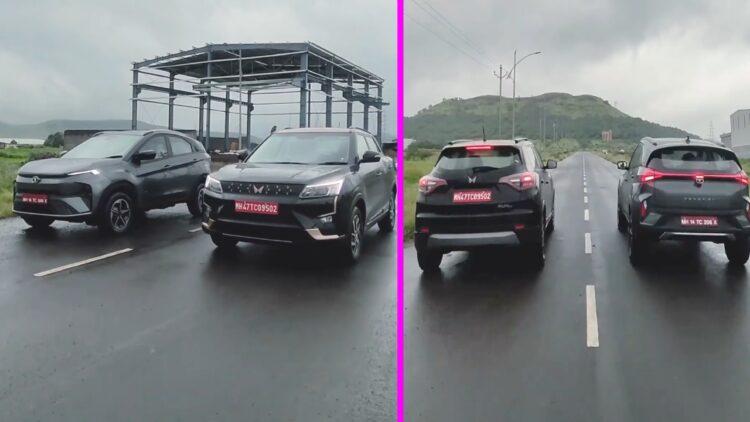This latest drag race competition between a Mahindra XUV400 and a Tata Nexon EV is quite exciting. Both these are extremely popular electric SUVs in our market. While the Nexon EV is the most successful EV in India in terms of sales with over 70% market share, the XUV400 is also a worthy alternative and is selling relatively well. Electrification is getting mass adoption across the globe and India is no different. Even though the challenges with the charging infrastructure continue, there is also rapid development in this space. Let us take a look at the details of this latest case.
You may also like: 5 New Features of Tata Nexon EV Facelift
Mahindra XUV400 vs Tata Nexon EV Facelift Drag Race
This post comes from autocar_india on Instagram. It captures the two electric SUVs side-by-side. On the count of three, the SUVs are accelerated with full force. They remain close to each other during this race. Finally, the XUV400 was able to reach 100 km/h speed from a standstill in just 9 secs. The Nexon EV facelift was able to accomplish the same in 9.3 secs. Hence, both SUVs clock the 0-100 km/h sprint in under 10 secs, which is quite remarkable. The inherent instant torque delivery in electric cars ensures such blistering performance.
You may also like: Anand Mahindra Gifts XUV400 to Chess Champion Praggnanandhaa
Specs Comparison
Tata Nexon EV
The Tata Nexon EV comes in two different versions – MR (Medium Range) and LR (Long Range). You have a choice of two battery options – a 30.2 kWh and a 40.5 kWh, providing claimed ranges of 325 km and 465 km, respectively. These electric models offer impressive power and torque, boasting peak power and torque figures of 127 hp / 215 Nm and 143 hp / 215 Nm. As for charging, both versions can be fully charged from 10% to 100% in just 56 minutes using a DC fast charger. Alternatively, with the 7.3 kW AC charger, the MR variant can complete the same task in 4.3 hours, while the LR variant takes 6 hours.
You may also like: New Tata Nexon EV vs Mahindra XUV400 – Specs, Price Comparison
Mahindra XUV400
The Mahindra XUV400 comes equipped with two battery options – a 34.5 kWh and a 39.4 kWh LFP battery. These boast an IP67 rating for durability and protection. These batteries power the electric motor, delivering a notable 150 PS and 310 Nm of peak power and torque. Thanks to this robust powertrain, the EV accelerates from 0 to 100 km/h in a swift 8.3 seconds, showcasing impressive speed. Its maximum speed is conveniently limited to 150 km/h. Depending on the battery variant, under optimal conditions, it offers an impressive range of 375 km and 456 km on a single charge. Using a 50 kW DC fast charger, it can recharge from 10% to 80% in just 50 minutes.
| Specs Comparison | Mahindra XUV400 | New Tata Nexon EV |
| Battery | 34.5 & 39.4 kWh | 30.2 & 40.5 kWh |
| Power | 150 PS | 127 PS / 143 PS |
| Torque | 310 Nm | 215 Nm |
| Range | 456 km | 465 km |
| DC Fast Charging | 50 mins (10-80%) | 56 mins (10-100%) |
| Boot Space | 368 litre | 350 litre |
You may also like: Tata Punch Facelift Conceptualised with Nexon-Like Soft Parts
What We Think
Recently, YouTubers and vloggers have eagerly adopted the use of drag races as a means to assess and contrast the capabilities of various cars. Nevertheless, it’s crucial to acknowledge that depending solely on drag races for these evaluations may not be the most prudent method. This apprehension arises from the possibility that drag races can lead to lasting harm to vehicles, as the majority of cars are not designed for extended high-speed, straight-line racing. Consequently, we strongly discourage any endeavours to engage in drag races with your personal vehicle. In actuality, most drivers steer clear of pushing their cars to such extreme boundaries, primarily due to safety concerns.
You may also like: India’s First Electric Car Happened 27 Years Before Tata Nexon EV’s Arrival
You may also like: India’s Cheapest Electric Car Costs Lesser Than Hero Splendor, Can be Home Delivered
Disclaimer- The embedded videos/ external content is/are being used as a convenience and for informational purposes only; they do not constitute an endorsement or approval by Car Blog India of any of the products, services, and /or opinions of the corporation or organization or individual. Car Blog India bears no responsibility for the accuracy, legality, and/or content of the external site or for that of subsequent external videos/ external content. Contact the external publisher for answers to questions regarding its content.


